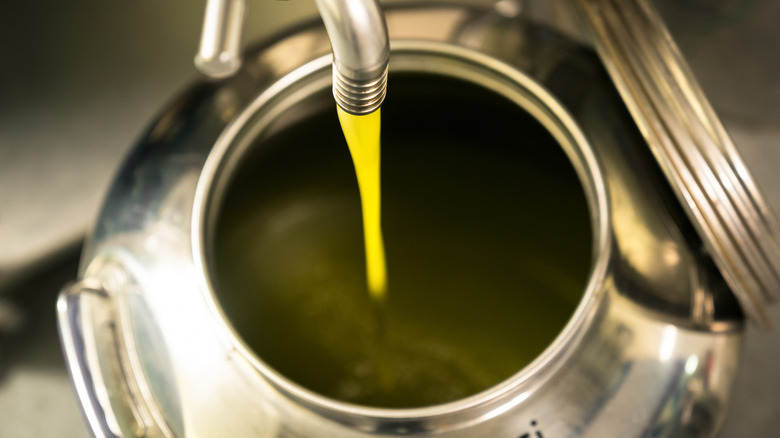What Are All The White Particles In Olive Oil?
Olive oil, that beloved foundation of the vaunted Mediterranean diet and favorite of chefs both pro and plebeian, is a culinary superstar. It's full of healthy fats, and studies have found that it contains a wealth of antioxidants. This makes it a rare example of delicious food that you don't have to feel soul-crushing guilt about eating. However, nothing is good for you if it's gone bad, and if you spot little white particles forming in your olive oil, your instinct may be to pitch it — but you probably shouldn't.
You might assume these flecks of white are patches of mold, but this might not be the case. If you're trying to tell if your olive oil has gone bad, taste and smell are the only true indicators, according to Healthline. If it tastes bitter or smells like a box of crayons, it's time to throw that bottle out. As for any white particles you may see floating around in your olive oil, they are most likely solidified bits of wax, per Metro. This can sound disturbing at first, but it is safe to consume, and there is a natural explanation for its presence.
White particles are a sign of temperature
As the Atlantic explains, all fruits are coated in a natural wax film that protects them from drying out or getting saturated with rainwater. You can easily see the evidence of this wax on the skin of dark fruits like plums. You might see what looks like a sprinkling of fine white powder on the surface, but this is simply crystallized fat. The same protective film can be found on olives, and, according to Metro, a lot of that waxy layer gets pressed into the olive oil itself. If the oil is exposed to cold temperatures, the wax will start to congeal and clump together, creating the white specks you see in the bottle.
According to the Daily Mail, the natural wax in olive oil solidifies around 10 degrees Celsius, which is 50 degrees Fahrenheit. If the temperature in your pantry drops to this level, you shouldn't be at all surprised to find cloudy specks in your olive oil — all you need to do to remove them is warm it up. You can also buy winterized olive oil, which olive oil maker Centra Foods explains has been exposed to the cold. As a result, the solidified wax has been removed. This prevents white particles from forming, but the processing means it no longer qualifies as extra virgin olive oil, and may lose some of its natural flavor.

